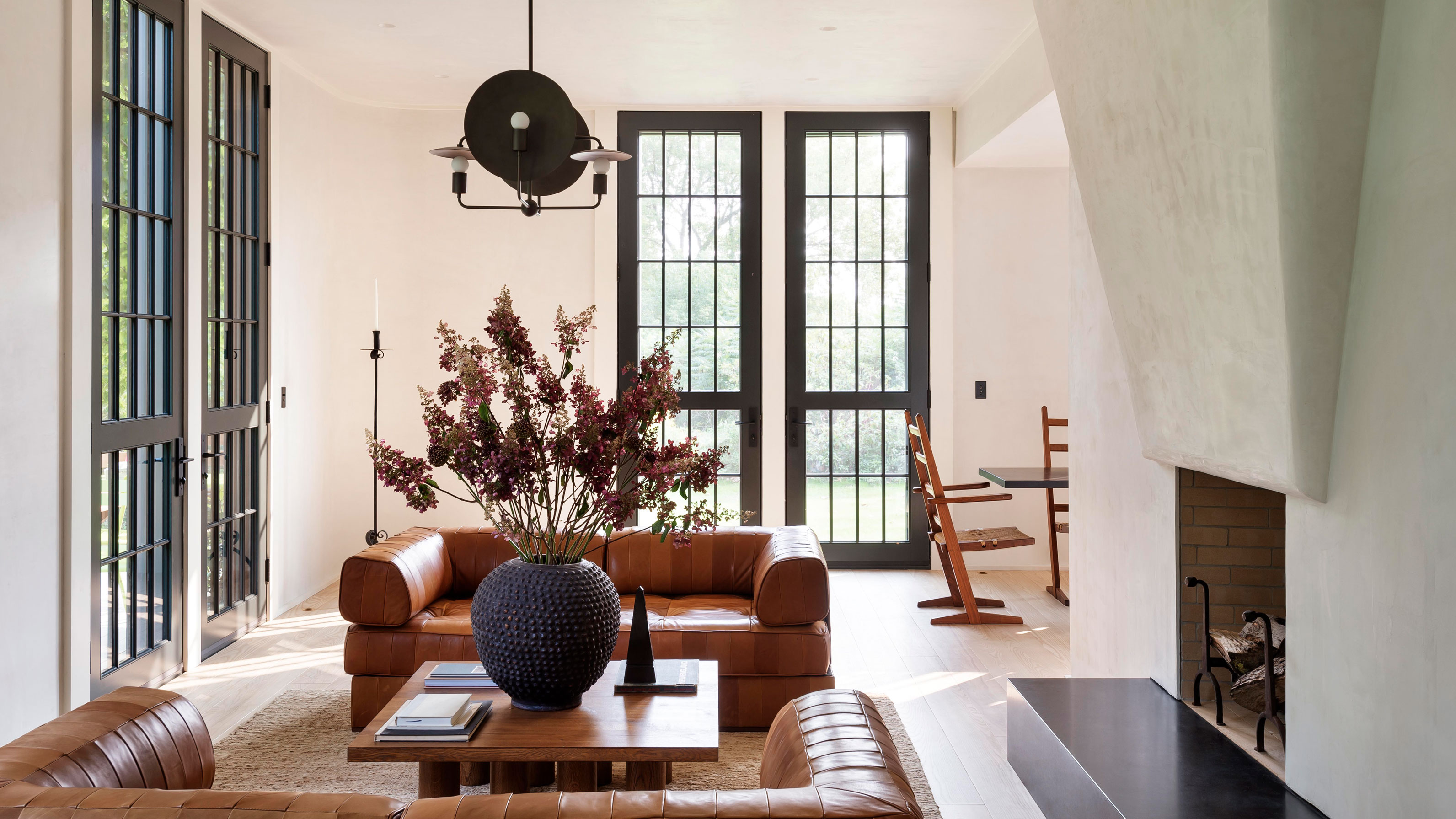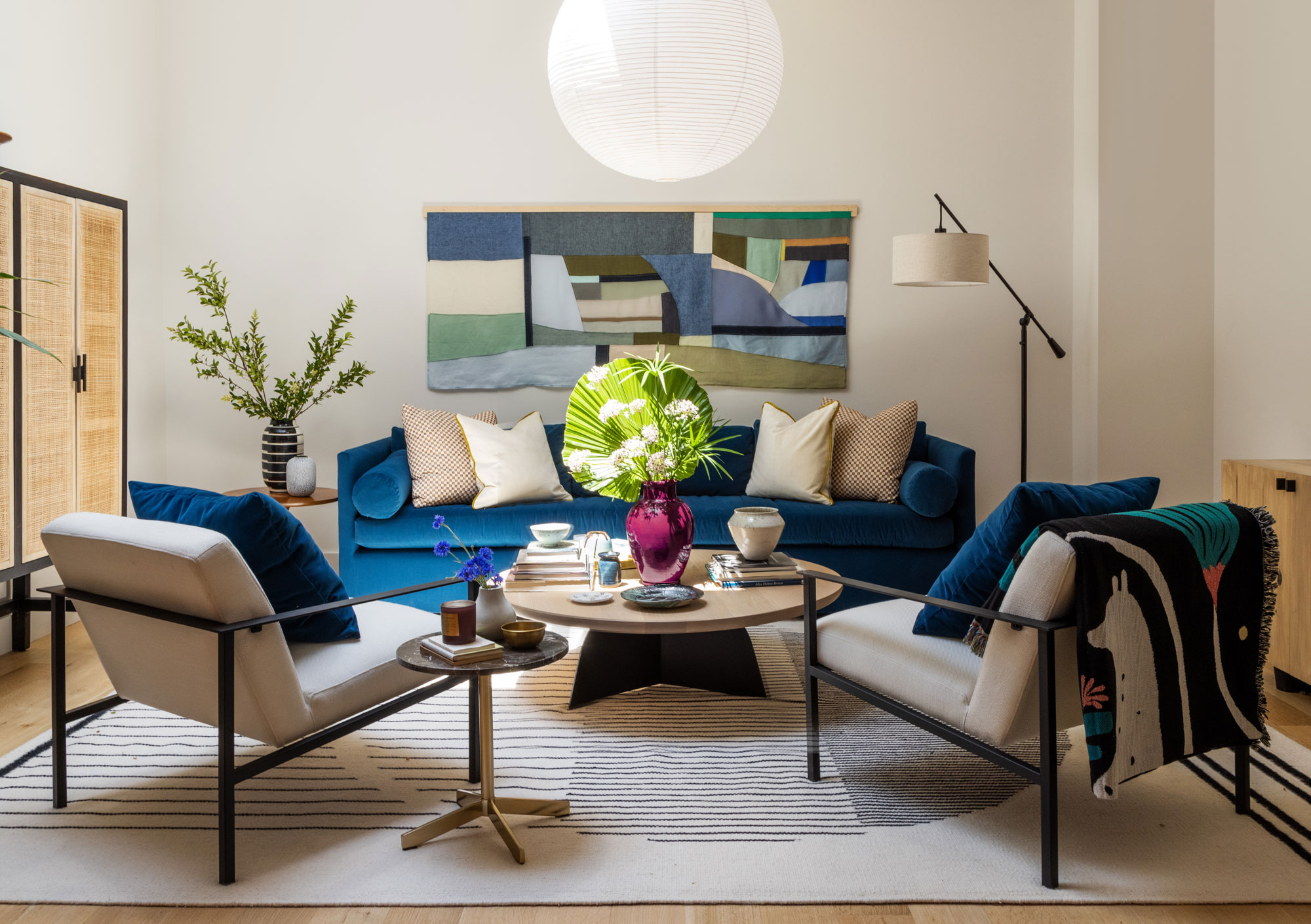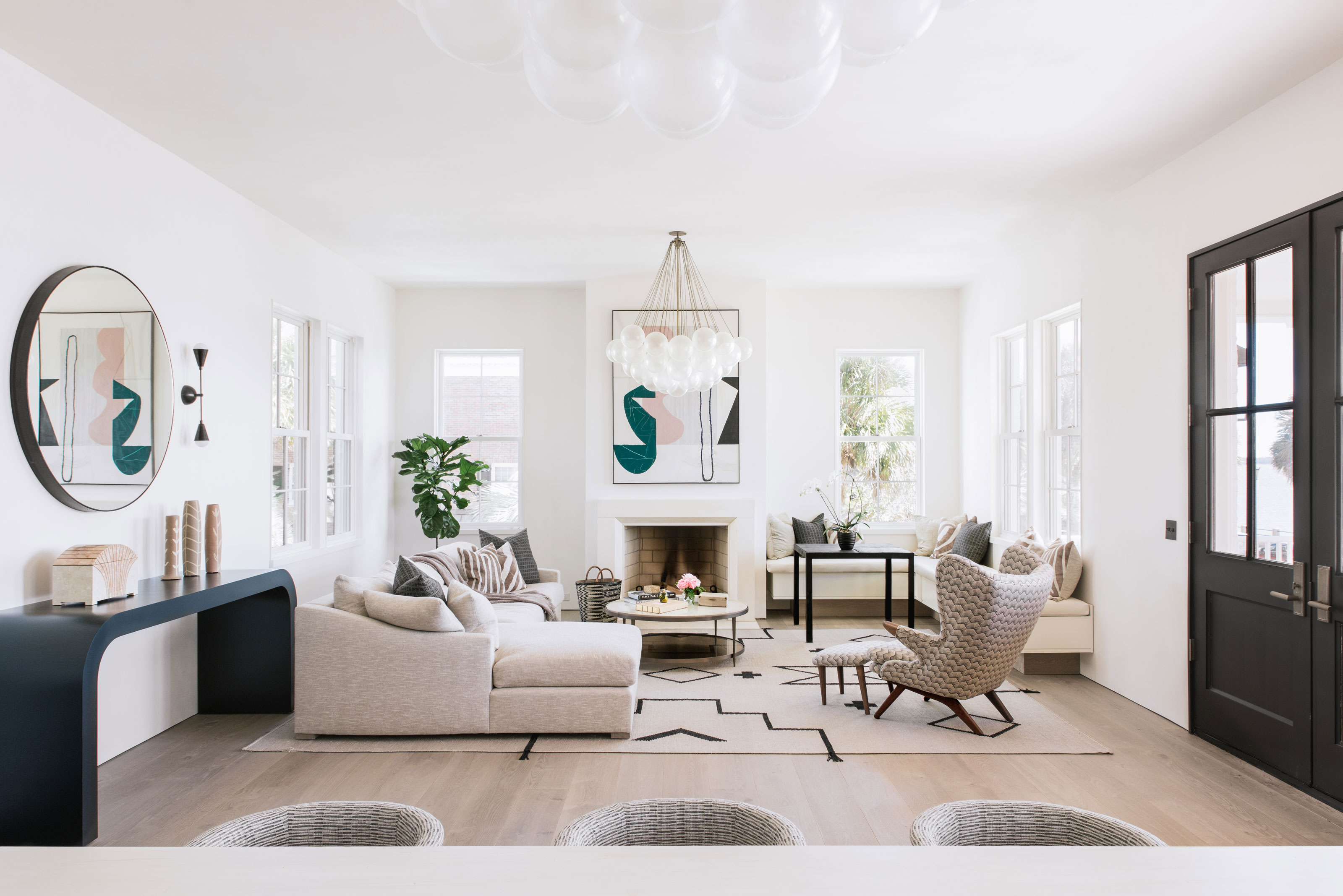Living room ceiling light ideas – interior designers on stylish ways to illuminate your space
Designers tell us their favorite living room ceiling light ideas and offer expert advice for a cozy but good-looking lighting scheme

Your choice of living room ceiling light ideas can really make or break your design. So, once you’ve poured your heart and soul into creating the perfect space in which to relax and unwind – next up on the checklist is finding a ceiling light so that you can make sure it will always be beautifully lit.
Of course, choosing the right material for the living room idea you want to achieve is key, but you’ll also want to take into consideration the amount of light a fixture offers as well as its suitability for your room.
From style ideas to the practicalities of getting your ceiling lighting right, with this expert guide on hand to steer you in the right direction, you’re sure to find the perfect lighting solution for your space.
8 living room ceiling light ideas for practicality and style
1. Keep it simple and elegant with a white paper shade

A classic choice, and for very good reason – a white paper lantern is a truly timeless living room lighting idea. Its origins can be traced back centuries in Chinese and Japanese culture, but it began to gain popularity in America and Europe in the 1950s when acclaimed sculptor Isamu Noguchi reimagined the traditional lanterns into electrical lighting designs.
‘We like paper lanterns because they give a room a soft diffused glow - at night they feel like the moon suspended,’ says Keren Richter, co-founder and principal designer at White Arrow. ‘When installed with dimmers, a paper or silk lantern can really enhance the warmth of space in a subtly beautiful way.’
There are many styles and designs to choose from - Noguchi’s original series of Akari lamps are still being produced - and Keren advises going big for maximum impact. ‘I’m a fan of really large-scale Noguchi pendants, the bigger the better!’ she says. ‘Just take into account hanging height and don’t block any important sightlines.’
2. Make a subtle statement and go for glass

It’s no secret that glass is a wonderful material for a ceiling light – it’s beautifully reflective and effortlessly elegant. But you can also really harness the ‘barely-there’ quality of glass to make an impressive design statement that won’t detract from the rest of the room.
The Livingetc newsletters are your inside source for what’s shaping interiors now - and what’s next. Discover trend forecasts, smart style ideas, and curated shopping inspiration that brings design to life. Subscribe today and stay ahead of the curve.
This elegant living room by Cortney Bishop Design does exactly that - the ceiling light is a sizable piece and a beautiful element within the space, but its translucent nature allows for the other parts of the room to sing too.
‘We wanted a light fixture that was rather large in size to fit the airy open space, but we were also after something unique and elegant,’ explains Cortney Bishop, principal designer and owner of Cortney Bishop Design. ‘This ‘Cloud’ chandelier by Apparatus Studio fulfilled our requirements exactly, and looks both modern and sophisticated. The glass globes reflect light beautifully, while providing a subtle glow in the evenings.’
3. Create warmth with natural materials

As beautiful as it is, glass might not be the right ceiling light material to choose in your living room. If you’re after something with more of an inherent warmth, going for natural materials will be a better bet.
‘This pendant is a series of rattan panels, a lovely material with warmth and tactility,’ says Andrew Griffiths, founder of A New Day. ‘It softens the feel of the space and provides a balance to the rich and moody wall paneling. By contrast,’ he says, ‘a glass or metal pendant would have felt quite hard and cold here, and would have got lost visually against the internal glazing.’
Andrew also emphasizes the importance of not only how the ceiling light looks within the living room, but how it might look from adjoining rooms and passageways too. ‘It’s so important to consider sightlines in a home,’ he says. ‘It’s not just about how a light fitting looks in the room, but the view of it you get from other connecting spaces. This living space has a wall of Crittall-style glazing into the hallway, so opting for this large sculptural fitting visually draws you into the living room when you enter the hall.’
4. Consider designs with multiple light sources

The key to a successful lighting scheme is layers. In addition to a ceiling light, you should try to include floor lamps, table lamps and possibly even wall lights too for maximum versatility – so it makes sense to choose a ceiling light with multiple light sources that will work extra hard and provide some additional layers for you.
‘The importance of light in a room can not be overstated,’ says Stefanie Brechühler, co-founder of Brooklyn-based interior design studio Workstead. ‘It’s not only the jewelry of a space, but it can really transform a room too.’ The other half of Workstead, co-founder Robert Highsmith agrees, and explains how a fixture with multiple sources can enhance a room.
‘In the case of this space, the fixture radiates light in four directions, allowing for ambient light in the room. Importantly,’ he says, ‘we always recommend ceiling fixtures to be dimmable and paired with a variety of other lighting in a room, to provide a wide range of options as the day turns into evening.’
In this modern rustic living room idea, this interesting pendant light design creates an unusual spread of light across the space.
5. Choose exposed bulbs

Another way to make your ceiling light work even harder is to opt for a piece that uses exposed bulbs. ‘Exposed bulbs will light both up, down, left and right - so you get an even distribution of light around the space,’ explains Alexandria Dauley, interior designer and founder of Dauley Designs. As well as the lighting benefits, exposed bulbs also offer a touch of industrial edge and modernity to any space.
The light from these kinds of designs can be quite strong, so Alexandria has the following advice to ensure you create a cozy living room atmosphere; ‘Always pop them on a dimmer, as they do give off quite a lot of light.’ It’s also worth noting that if you do decide to leave your bulbs bare, always make sure they’re aesthetically pleasing – filament bulbs, or frosted globe bulbs will be your best bet.
6. Hang a collection of ceiling lights in a cluster

Some say you can never have too much of a good thing, and if you’re looking to make a feature out of your ceiling lighting, then suspending a bountiful cluster is sure to tick the box. ‘We particularly like this piece as it spreads light beautifully, is unexpected due to the colors and shapes of each shade and cord, and is earth friendly too as it’s made of recycled materials.’ says Amy Lau, New York-based interior designer and founder of Amy Lau Design. The design introduces a palette of living room color ideas that is also picked up in the floor covering and soft furnishings.
When installing any electricals, it’s always important to consult an expert – and this is especially crucial when dealing with multiple fixtures. ‘This piece is manufactured so that the cable to each shade comes from a central location,’ says Amy. ‘Prior to installation, we worked closely with an electrician to determine the ceiling was wired correctly for the number of bulbs required. We then selected a design configuration with the number of shades, shapes, and colors that would work well in the space.’
7. Use ceiling lights to enhance your experience of a space

Not only can ceiling lights be a thing of beauty, but they can also be utilized as clever design devices to elevate the experience of your home - particularly in open plan spaces. This beautiful project by Prospect Refuge Studio is the perfect example, as they’ve used two different ceiling lights. The dining room lighting idea is a contrast the one in the seating area, delineating the space.
‘There is a psychological science behind the lighting we chose for this space and why we find it pleasing,’ explains Victoria Sass, principal and design director at Prospect Refuge Studio. ‘We've used statement fixtures in this project to create landmarks within a large volume of space. Looking through what could be an overwhelming amount of visual noise, one can effortlessly distinguish the dining from the entry, from the living room. These landmarks help us quickly and easily make sense of all the information we are taking in,’ she says, ‘which in turn helps us feel comfortable in the space, which ultimately makes us feel good.’
If you’re looking to combine two different lights in the same space Victoria offers some sound advice. ‘When deciding which lights to use together, it’s all about balance,’ she says. ‘Use a fixture with a lot of substance and sculptural presence next to one that utilizes negative space, or pair a fairly static piece with one that exhibits movement, or marry a compact design with an expansive one. Like people, opposites attract and don't be afraid of an unconventional pairing.’
8. Emphasize your room's finest features

Another insider tip to help you get the very most out of your ceiling lighting is to play to the strengths of your space – and if you have high ceilings, a long design is going to accentuate their allure. ‘Homes with grand, tall ceilings, sweeping staircases or statement entry tables look great with a longer pendant light hung above,’ says Keren Richter, co-founder and principal designer at White Arrow.
When it comes to choosing materials, Keren talks to the benefits of metallic finishes. ‘I like bringing sparkle and reflectivity into living rooms, particularly dark living room ideas where the metal finish will really pop,’ she says. ‘In monochromatic schemes, a metallic sheen plays an important role in helping the eye travel up and adding an additional glamorous element.’
What ceiling lights are best for a living room?
Living rooms are a great place to express your design style and identity, and making a statement overhead through the use of ceiling lighting will help the room feel considered from top to bottom. Start by working out what kind of materials and designs you are drawn to - be it warm and natural, or opulent and glamorous. From there, you’ll want to look for ceiling lights that offer a generous glow, and if it’s a design with multiple sources of light, then even better.
Alexandria Dauley, founder of Dauley Designs, emphasizes the importance of thinking about how the ceiling light will work in your particular room. ‘Think about the scale of your chosen design in relation to the room, as well as the height it will hang at and the light you want the fixture to cast.’
Where should living room ceiling lights be placed?
This will always depend on the room, as each space is different. Ideally, you want your ceiling light to sit centrally in the room – however, in an open place space, you would look to hang the living room ceiling light centrally over the sofa area.
Interiors stylist and journalist Amy Neason was the Deputy Style and Interiors editor at House Beautiful for years. She is now a freelance props and set stylist, creating work for a range of national publications and brands such as Imogen Heath. She has previously worked at Established & Sons, and her skills include styling still life and interiors shots for editorial features and sourcing unique products to create inspirational imagery.
She is particularly respected for interpreting seasonal trends into feature ideas and style stories.